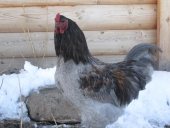


The Humble Soapnut - A Guide to the Laundry Detergent that Grows on Trees ebook by Kathryn Ossing
will be released to subscribers in:
soon!







 1
1




Iterations are fine, we don't have to be perfect
My 2nd Location:Florida HardinessZone:10 AHS:10 GDD:8500 Rainfall:2in/mth winter, 8in/mth summer, Soil:Sand pH8 Flat




S Bengi wrote:Abe, the fodder is basically multi-vitamins and the hay/roughage is just empty calorie.
And yes the sprouts/seed can produce more multi-vitamins than what they started out with. Obviously the calcium/minerals will not magically increase.
Every study and nutrient profile on Fodder that I have seen does not show a net increase of protein. Only the concentration increases, because the DM decreases.S Bengi wrote:The protein profile also changes(ratio between amino acids) and overall increases as it grows more cell etc.
actually, the calories decrease. but no one is proposing to feed an unbalanced diet. What we are trying to determine is at what stage of growth is the feed value maximized. Research seems to support the 4 day growth, whereas the fodder companies claim 6-8 days.S Bengi wrote:So while the total calorie (assuming the seed/plants did not absorb any sunlight) did not increase.
I am pretty sure your or any animal body would prefer to eat a more balance diet than just straight oil/calorie.
S Bengi wrote:Animals keep on eating if they dont have enough mineral or vitamins or calorie in their diet not just if they dont have enough calorie.
So with them now getting more vitamin in their diet it is very likely that they will eat less, because they are now satisfied
Buy Our Book! Food Web: Concept - Raising Food the Right Way. Learn make more food with less inputs
Off Grid Homesteading - latest updates and projects from our off grid homestead


 1
1




Iterations are fine, we don't have to be perfect
My 2nd Location:Florida HardinessZone:10 AHS:10 GDD:8500 Rainfall:2in/mth winter, 8in/mth summer, Soil:Sand pH8 Flat








Sherry Jansen wrote:Here's a list of times, grains and nutrient value of sprouts, crude protein, fiber/DM and other related sprouting stuff:
http://idosi.org/wasj/wasj16(4)12/9.pdf
Note, you don't NEED to add additional minerals, but just for assurances, we add a dusting of azomite or kelp before feeding.
I should also say, don't add too much kelp to the laying hens sprouts...the eggs can have a fishy smell!
And, final note, the sprout water should be given to animals immediately. It is great for baby chicks, calves, lambs and chock full of electrolytes for starting them off right. Do not let it sit out and ferment in water air temps.

Ollie Puddlemaker








Ollie Puddlemaker








John Polk wrote:
http://idosi.org/wasj/wasj16%284%2912/9.pdf




Buy Our Book! Food Web: Concept - Raising Food the Right Way. Learn make more food with less inputs
Off Grid Homesteading - latest updates and projects from our off grid homestead
















My project thread
Agriculture collects solar energy two-dimensionally; but silviculture collects it three dimensionally.




Cj Verde wrote:I'm doing a test this week in an unused bath tub. I'm soaking 5 lbs of sunflower seeds for a few days. Then I'll pour it into the tub (I guess through a colander). Anyone know how much extra watering is necessary?
Buy Our Book! Food Web: Concept - Raising Food the Right Way. Learn make more food with less inputs
Off Grid Homesteading - latest updates and projects from our off grid homestead









Owner, Etta Place Cider








 1
1




Dave's SKIP BB's / Welcome to Permies! / Permaculture Resources / Dave's Boot Adventures & Longview Projects














 2
2




Milo Jones wrote:Somewhat related Many Trendy 'Microgreens' Are More Nutritious Than Their Mature Counterparts
ScienceDaily (Aug. 29, 2012) — The first scientific analysis of nutrient levels in edible microgreens has found that many of those trendy seedlings of green vegetables and herbs have more vitamins and healthful nutrients than their fully grown counterparts.
$10.00 is a donation. $1,000 is an investment, $1,000,000 is a purchase.




Tomorrow doesn’t exist and never will. There is only the eternal now. Do it now.




Nican Tlaca




Milo Jones wrote:Somewhat related Many Trendy 'Microgreens' Are More Nutritious Than Their Mature Counterparts
ScienceDaily (Aug. 29, 2012) — The first scientific analysis of nutrient levels in edible microgreens has found that many of those trendy seedlings of green vegetables and herbs have more vitamins and healthful nutrients than their fully grown counterparts.




Cindy Skillman wrote:The issue of mold can be mitigated by thorough and timely rinsing and by a non-moldy environment. If you try to sprout a batch of seeds under the kitchen sink, for example, you’re likely to have some mold. What kitchen sink has never leaked, after all? As for mixing seeds, I’ve never read anything about that. Maybe try to use seeds with a similar germination period... not sure that would make a difference, but I guess it could.
$10.00 is a donation. $1,000 is an investment, $1,000,000 is a purchase.

|
There is no "i" in denial. Tiny ad:
Freaky Cheap Heat - 2 hour movie - HD streaming
https://permies.com/wiki/238453/Freaky-Cheap-Heat-hour-movie
|





